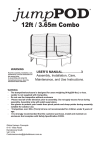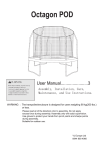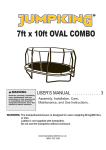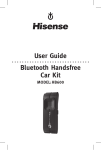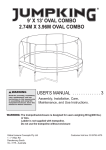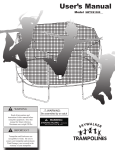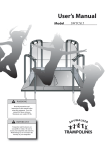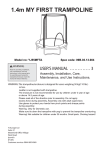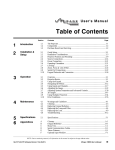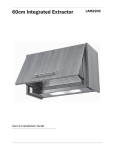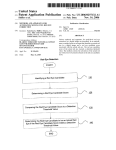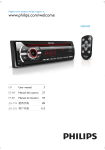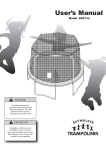Download 8ft / 2.44m Combo
Transcript
8ft / 2.44m Combo WARNING Read the assembly, installation, care, maintenance, and use instructions in this manual prior to assembling and using this trampoline/enclosure. Save this manual for future reference. Assembly, Installation, Care, Maintenance, and Use Instructions. WARNING: - The trampoline/enclosure is designed for users weighing 90 kg(200 lbs.) or less. - Ladder is not supplied with trampoline. - Do not use the trampoline without enclosure - Please read all of the instructions prior to assembly. Do not apply excess force during assembly. Assembly only with adult supervision. - Use gloves to protect your hands from pinch points and sharp points during assembly. - Suitable for outdoor use. - Trampolines over 20in. (51cm) tall are not recommended for children under 6 years of age. Global Leisure Concepts 8-10 Villas Road Dandenong South VIC 3175 [email protected] 2 QUESTIONS? If you have questions after reading this manual,please visit our Customerservice website. [email protected] REPLACEMENT PARTS 8ft / 2.44m Combo 1. The owner and supervisors of the trampoline are responsible to make sure all the users are aware of practices specified in this manual. gerous and can cause serious injuries. 13. Focus your eyes on the edge of the trampoline. This will help control your bounce. 2. Supervision is recommended at all times. 3. Keep the trampoline on a level surface. 4. Must place the trampoline on lawn, bark wood chip, sand or cushioning materials. 3. Adequate overhead clearance is essential. A minimum of 8 m from ground level is recommended. Provide clearance from wires, tree limbs, and other possible hazards. 4. Maintain a free space of minimum 2500mm on all sides of the trampoline. This area should not included concrete, bitumen, brick, or other hard surfaces as these can cause serious injuries. Note: For Trampoline with enclosures, the free space may be reduced to 1500mm. 14. Avoid bouncing for too long. Do not bounce when tired. 15. Stop your bounce by flexing your knees as your feet come in contact with the trampoline bed. Learn this skill before you attempt any others. 16. Climb on and off the trampoline, do not jump. It is a dangerous practice to jump from the trampoline to the floor or ground when dismounting, or onto the trampoline when mounting. Always use two hands on the frame getting on and off the trampoline. Never use springs or suspension elements as ‘hand grips’. 5. Lateral clearance is essential. Place the trampoline away from walls, structures, fences, and other play areas. Maintain a clear space on sides of the trampoline. 17. Learn fundamental bounces and body positions thoroughly before trying more advanced skills. A variety of trampoline activities can be carried out by performing the basic fundamentals in various series and combinations, or performing one fundamental after the other, with or without bounces between them. 6. Use the trampoline in a well lighted area. Artificial illumination may be required for shady areas. 18. Avoid bouncing too high. Stay low until you can control your bounce and repeatedly land in the centre of the trampoline. 7. Secure the trampoline against unauthorized and unsupervised use. If an access ladder is used, it should be removed when the trampoline is not in use. 19. Do not use the trampoline as a springboard to other objects. Use the trampoline only for trampoline style bouncing. 8. Inspect the trampoline and trampoline enclosure before each use. Make sure the frame padding is correctly and securely positioned. Replace any worn, defective, or missing parts. 20.Keep objects away that could interfere with the person jumping. 21. For further information or additional instructional materials, contact your nearest trampoline club. 9. Remove any obstructions from beneath the trampoline. 22. It is advisable not to bounce immediately after a meal. 10. The trampoline is designed for users weighing 90kg (200 lbs.) or less. Trampolines greater than 500mm in height are not recommended for children under six years of age. 23. Do not attempt knee drops as these can cause injury if you attempt this skill without some experience or personal instruction. 11. Allow only one person on the trampoline and trampoline enclosure at any time. Use by more than one person at the same time may result in serious injury. 12. Misuse and abuse of the trampoline is dan- 24. Your clothing should allow plenty of body freedom, but no flapping shirts or skirts to distract your concentration. 25. No buckles or jewellery should be worn, as these could damage the trampoline mat and cause injury to you. 26. Do not wear shoes while bouncing on the trampoline. 39. Do not attempt to jump over the netting. 27. Use the trampoline and trampoline enclosure only with mature, knowledgeable supervision at all times. 40. Do not intentionally rebound off the netting. 41. Keep all frame and heat sources away from the product. 28. Injury may result from encountering the frame or falling through the springs while getting onto or off the trampoline or while jumping. Stay in the center of the bed when jumping. Do not use the trampoline without the frame pad securely in place to cover the frame. The frame pad is not designed or intended to support the weight of the user. Do not step or jump directly onto the frame pad. 42. The trampoline frame and the enclosure are made of metal. They are not grounded, and they will conduct electricity. Therefore, an electrocution hazard exists. 43. Keep objects away which could interfere with the user. Maintain a clear area around, above, and under the trampoline. 29. The trampoline is a rebounding device that propels the user to unaccustomed heights and into a variety of body movements. Rebounding off the trampoline, striking the frame or springs, or improperly landing on the bed may cause injury. 44. Do not use trampoline without enclosure. 45. Do not use the trampoline when wet. 30. Do not attempt or allow somersaults. This can result in a broken head, neck, back, or leg. Landing on the head or neck can cause serious injury, paralysis, or death, even landing on the middle of the bed. 46. Do not jump onto or off the trampoline. 47. Do not allow any activity underneath the trampoline. 48. Do not use trampoline without mature, and knowledgeable supervision. 31. Do not use a trampoline while under the influence of alcohol or drugs. These substances impair reaction time, judgement, and physical coordination. 49. The following conditions could represent potential hazards: (i) Missing, improperly positioned, or insecurely attached frame padding. (ii) Punctures, frays, tears or holes worn in the bed or frame padding. (iii) Deterioration in the stitching or fabric of the bed or frame padding. (iv) Broken or stretched springs. (v) A bent or broken frame. (vi) A sagging bed. (vii) Sharp protrusions on the frame, padding or suspension system. (viii) Damaged or degraded padding. 32. Do not jump on the trampoline while holding an object, particularly one that is sharp or breakable. 33. Bounce only when the surface of the bed is dry. Wind or air movement should be calm to gentle. The trampoline must not be used in gusty or severe winds. 34. The trampoline enclosure is to be used only as an enclosure for this trampoline. 35. Do not attach anything to the netting that is not a manufacturer approved accessory or part of the enclosure. 36. Wear clothing free of drawstrings, hooks, loops, or anything that could get caught in the netting. 37. Enter and exit the trampoline enclosure only at the door designed for that purpose. 38. Do not attempt to crawl under the netting. WARNING PLACARD PLACEMENT WARNING Do not use trampoline and trampoline enclosure without mature, and knowledgeable supervision . Label 2 Label 1 Do not attempt or allow somersaults . Do not allow more than one person on the trampoline and trampoline enclosure at any time . Do not use the trampoline when wet. Do not jump onto or off the trampoline. Do not use a trampoline while under the influence of alcohol or drugs. Do not allow any activity underneath the trampoline. Do not use trampoline without enclosure. Inspect the trampoline before each use. Make sure the frame padding is correctly and securely positioned. Replace any worn, defective, or missing parts. Keep objects away which could interfere with the user. Maintain a clear area around, above, and under the trampoline. Learn fundamental bounces and body positions thoroughly before trying more advanced skills. Do not use trampoline without mature and knowledgeable supervisor. Do not a empt or allow somersaults. Do not allow more than one person on the trampoline at all mes. Do not use trampoline when wet. Replace the ne ng and the padding over the springs and frame on your trampoline every 12 months. You should replace the padding and ne ng sooner if it shows signs of damage, wear and tear of fa gue. DO NOT USE WITHOUT FRAME PADS! - MAXIMUM USER MASS 90 KG. JK0813B2 Complies with AS 4989 2006 JK0813B2 Complies with AS 4989 2006 This labels shown on this page have been attached to the trampoline in the indicated locations. The placard will be attached by the owner(see step 7 on page 18). If one of the labels or the placard is missing or illegible, visit our Customer service website (see page 3) and order a free replacement label or placard. Attached the label or placard in the location shown. JK0813B2 Placard (to be attached by the owner) Complies with AS 4989 2006 Note: The labels and the placard are not shown actual size. The placard shown at the right must be attached to the trampoline enclosure by the owner (see assembly step 14 on page 20). If the placard is missing or illegible, visit our Customer service website at [email protected] to order a free replacement placard. Note: The placard is not shown actual size. JK0813B2 Complies with AS 4989 2006 6 BEFORE YOU BEGIN Thank you for selecting a Combo trampoline/ HQFORVXUHĀ&RPERā are designed and crafted to provide many years of fun and fitness. This trampoline/enclosure come equipped with warnings and instructions for the assembly, care, maintenance, and use of the trampoline/enclosure. This information must be read by all trampoline supervisors and users before any person is allowed to jump and use enclosure on the trampoline. If you have questions after reading this manual, please call our Customer service website at [email protected] To help us assist you. TRAMPOLINE SAFETY INFORMATION Loss of Control: Jumpers who lose control of their jump may land on the mat incorrectly, land on the frame or springs, or fall off the trampoline. A controlled jump is one where the landing is in the same spot as the takeoff. Before learning a more difficult manoeuvre, the preceding one should be performed consistently under control. Attempting a manoeuvre beyond present skill levels increases the chance of loss of control. To regain control and stop your jump, bend your knees sharply when you land. In trampoline use, as in all active recreational sports, participants can be injured. However, there are steps that can be taken to reduce the risk of injury. In this section, primary accident patterns are identified and the responsibilities of supervisors and jumpers in accident prevention are described. ACCIDENT CLASSIFICATION Somersaults (flips): Landing on your head or neck, even in the middle of the trampoline mat, increases the risk of a broken back or neck, which can result in paralysis or death. Such events can occur when a jumper makes an error trying to perform a forward or backward somersault (flip). Do not perform somersaults (flips) on this backyard trampoline. Alcohol or Drug Use: The chance of injury increases when a jumper has consumed alcohol or taken drugs. 7KHVHVXEVWDQFHVLPSDLUDSHUVRQÿVUHDFWLRQWLPH judgment, and physical coordination. Encountering Objects: Use of a trampoline while other people, pets, or objects are underneath it will increase the chance of an injury. Jumping while holding or having an object on the trampoline, particularly one that is sharp or breakable, will increase the chance of injury. Placing a trampoline too close to overhead electrical wires, tree limbs, or other obstructions can increase the chance of injury. Multiple Jumpers: More than one jumper on the trampoline increases the chance of a jumper becoming injured by losing control of his or her jump. Jumpers may collide with one another, fall off the trampoline, fall on or through the springs, or land incorrectly on the mat. The lightest weight jumper is the jumper most likely to be injured. Poor Maintenance of the Trampoline: Jumpers may be injured if a trampoline is used when it is in poor condition. A torn mat, bent frame, broken spring, or missing frame pad, for example, should be replaced before anyone is allowed to jump. Inspect the trampoline before each use. Mounting and Dismounting: The trampoline mat is several feet from ground level. Jumping off the trampoline to the ground or any other surface may result in injury. Jumping onto the trampoline from a roof, deck, or other object also represents a risk of injury. Smaller children may need assistance getting onto or down from the trampoline. Climb carefully onto and off the trampoline. Do not step onto the springs or the frame pad. Do not grasp the frame pad to pull yourself onto the trampoline. Weather Conditions: A wet trampoline mat is too slippery for safe jumping. Gusty or high winds can cause jumpers to lose control. To reduce the chance of injury, use the trampoline only under appropriate weather conditions. Striking the Frame or the Springs: Injury may result from encountering the frame or falling through the springs while jumping or getting onto or off the trampoline. Stay in the centre of the mat when jumping. Make sure to keep the frame pad in place to cover the frame. The frame pad is not designed nor intended to support the weight of the trampoline user. Do not step or jump directly onto the frame pad. 7 METHODS OF ACCIDENT PREVENTION 7KH6XSHUYLVRUÿV5ROHLQ3UHYHQWLQJ$FFLGHQWV It is the responsibility of the supervisors of trampoline users to provide knowledgeable and mature supervision. They need to know and enforce all the rules and warnings set forth in this manual to minimize the likelihood of accidents and injuries and to inform users of these rules. During periods of time when supervision is unavailable or inadequate, this may require that the trampoline be disassembled, placed in a secure area, or otherwise secured against unauthorized use. Another option that may be considered is covering the trampoline with a heavy tarp that can be secured with locks and chains. It is the responsibility of the supervisor to make sure that the placard with TRAMPOLINE SAFETY INSTRUCTIONS (see step 7 on page 18) is kept posted on the trampoline and that jumpers are informed about these instructions. 7KH-XPSHUÿV5ROHLQ3UHYHQWLQJ$FFLGHQWV Education on the part of the user is a must for safety. Users must first learn a low, controlled bounce and then learn the basic landing positions and combinations before proceeding to intermediate skills. Jumpers PXVWXQGHUVWDQGZK\WKH\KDYHWRPDVWHUĀ FRQWUROā before they can start thinking about other moves. Understanding the proper progression of skills in jumping on a trampoline must be the first lesson. Review this manual to learn about the basic techniques for using the trampoline. Follow the rules on the placard with TRAMPOLINE SAFETY INSTRUCTIONS (see step 7 on page 18). For further information or additional instructional materials, contact a certified trampoline instructor. Inspect the trampoline before using it. Do not use the trampoline without the frame pad securely in place to cover the frame. Do not use the trampoline when it is wet or in a windy condition. A worn or damaged mat, spring, or frame piece should be replaced immediately. Keep objects away that could interfere with the jumper. Secure the trampoline against unauthorized and unsupervised use. For the Jumper Do not use the trampoline when under the influence of drugs or alcohol. Avoid bouncing when tired. JUMPING Learn fundamental jumps and body positions thoroughly before trying more advanced skills. Be alert to your own limitations in the execution of trampoline skills. Review this manual to learn how to do basic jumps. Stop your bounce by flexing your knees as your feet come in contact with the trampoline mat. Learn this skill before attempting others. Avoid jumping too high or for too long. Always control your jump. A controlled jump is one where the takeoff and landing spots are the same. Bounce in the centre of the trampoline. Focus your eyes on the frame pad. Failure to do so may result in a loss of balance and control. TRAMPOLINE SAFETY INSTRUCTIONS For the Supervisor Read the instructions before using the trampoline. Enforce all of the safety rules and be familiar with the information in this manual to help new users learn basic jumps and all users follow trampoline safety. All trampoline users must have mature, knowledgeable supervision, regardless of the skill or age of the jumper. Take turns jumping, one at a time, and always have someone watch you. GETTING ON AND OFF Climb onto and off the trampoline; do not jump onto it or off it. Do not use the trampoline as a springboard to other objects. This trampoline is not recommended for use by children under 6 years of age. 8 TRAMPOLINE ENCLOSURE SAFETY INFORMATION NEED FOR TRAMPOLINE ENCLOSURE SAFETY A trampoline enclosure is a recreational product. The information on this page and on page 10 identifies important safety precautions. The precautions are not all-inclusive, because an enclosure can be used in ways that this manual cannot cover completely. To prevent pinches and cuts during enclosure use, a frame pad must be installed on the trampoline. 6HHWKHWUDPSROLQHPDQXIDFWXUHUÿVLQVWUXFWLRQ The frame pad must be installed before the enclosure is erected. The frame pad reduces the chance of injury from accidental contact with the springs and frame. USING THE ENCLOSURE SAFELY Adult Supervision of Children Children using a trampoline with a trampoline enclosure must be supervised by adults. Young children must be supervised constantly. Adults must pay particular attention to: - things that children bring into the enclosure. children’s activities inside the enclosure. conditions inside the enclosure while children are using it. the way children get into and out of the enclosure. Additional details of safe enclosure use are described below. Electrocution Hazard Associated with the Metal Frame of the Trampoline and Enclosure The trampoline and enclosure frames are made of metal. They are not grounded, and they will conduct electricity. Lights, electric heaters, extension cords, and household electrical appliances are not permitted in or on the trampoline or enclosure. Hazards Associated with Entering and Exiting the Trampoline Enclosure A trampoline enclosure installed on a trampoline is raised off the ground. The height of the enclosure increases the risk of a fall when a jumper is entering or exiting the enclosure. Young children in particular may have difficulty getting into and out of the enclosure. To reduce the risk of falling, help young children to get into and out of the enclosure. Enter and exit the trampoline enclosure only through the door of the enclosure (the opening in the netting walls). The trampoline mat and the netting walls of the enclosure are separate pieces; jumpers, particularly young children, must not exit the enclosure by going out between the mat and the netting walls. Trying to exit in this way poses a risk of strangulation from being caught between the trampoline frame and the netting walls. Darkness increases the chances of a fall when a jumper is entering or exiting the enclosure. Do not use the trampoline unless adequate lighting is provided. Hazards Associated with Animals and Sharp and Breakable Objects To avoid damage to the trampoline enclosure and the trampoline, do not allow pets or other animals inside of the enclosure. The claws and teeth of animals can damage the netting. Do not jump on the trampoline while holding or wearing a sharp or breakable object. 9 Hazards Associated with High Winds A trampoline with an enclosure can be moved or blown over by high winds, potentially injuring anyone in its path or anyone inside of the enclosure. If you anticipate high winds, take down the enclosure netting, and stake the trampoline frame to the ground (see page 21), or move the trampoline and enclosure to a sheltered location. Storing the Trampoline Enclosure Safely Specific steps for storing the trampoline enclosure are presented later in this manual. There are specific safety precautions to be aware of when storing the enclosure. Remove the attached tube sections as a unit, and separate them on the ground. Avoid pinching your fingers by keeping your fingers away from pinch points near the bracket assembly while you are removing the tubes from the frame. Placing the Trampoline in a Safe Place There must be at least 8 m of clear, open space above the trampoline mat. Do not place or store anything underneath the trampoline. To avoid injury, the trampoline must be kept away from objects and possible hazards including electric power wiring, tree limbs, and fences. Do not place the trampoline near any other recreational devices or structures such as a swimming pool or swing set. The trampoline must be placed on a level surface before use, and the area around the trampoline must always be well lighted. For the Supervisor This trampoline enclosure is not recommended for use by children under 6 years of age or by anyone weighing more than 200 lbs (90 kg). Use the trampoline only when the mat is clean and dry. Inspect the trampoline and enclosure prior to each use and replace any worn or damaged parts. Use only when the enclosure netting has no holes, the clamps are tightly secured to the tubes and the frame, and the netting is properly suspended. For the Jumper Do not attempt to jump over the netting. Do not intentionally rebound off the netting. Do not hang from, kick, cut, or climb on the netting. Wear clothing that is free of drawstrings, hooks, loops or anything that could get caught in the netting. Do not attach anything to the netting that is not an approved accessory or part of the trampoline enclosure. How to Enter and Exit the Trampoline Enclosure Enter and exit the trampoline enclosure only through the door in the netting. To enter the enclosure, first unfasten the plastic clips on the door and unzip the zippers. Place one knee on the frame pad and climb head first through the door. Refasten the plastic clips and close the zippers. To exit the enclosure, first unzip the zippers on the door and unfasten the plastic clips. Sit on the mat of the trampoline and climb feet first through the door. When you are through the door and sitting on the frame pad, step or jump safely to the ground. Close the zippers and refasten the plastic clips. Be familiar with the information in this manual and enforce all of the safety rules. Help new users and all users to use the trampoline and enclosure safely. All trampoline users must have someone watch them, regardless of the skill or age of the user. Secure the trampoline against unauthorized and unsupervised use. Keep the trampoline free of objects that could interfere with the jumper. 10 USE AND INSTRUCTIONAL MATERIAL OVERVIEW OF TRAMPOLINE USE The first periods of trampoline use should focus on learning fundamental body positions and practicing the eight basic bounces that are described on pages 12, 13 and 14 in this manual. During this learning period, jumpers should practise these basic techniques and perfect them. Braking, or checking the bounce, should be taught first and stressed as a safety measure. Jumpers should brake their jump whenever they start to lose balance or control. This is done by simply flexing the knees sharply upon landing and absorbing the upward thrust of the mat. This enables the jumper to stop suddenly and avoid losing control. In trampoline use, the takeoff point and landing point of a good, controlled jump are in the same spot. An exercise is considered learned only when a jumper is able to perform it consistently. Jumpers should never proceed to any advanced step until they can perform all previous techniques consistently. Allow each jumper a brief turn on the trampoline. Extended bouncing exposes an overtired user to an increased risk of injury. Longer turns tend to lessen the interest of others waiting to jump. Clothing should consist of a T-shirt and shorts. Jumpers should wear regulation gymnastic shoes or heavy socks, or they may jump barefoot. Street shoes or tennis shoes should not be worn on the trampoline. Beginning jumpers may wish to wear loose-fitting protective clothes, such as a long-sleeve shirt and pants, until correct landings are mastered. This will reduce the chance of mat (mat) burns from improper landings on elbows and knees. No hard-sole shoes should be worn, as they cause excessive wear on the trampoline mat. Mounting and dismounting properly should be a strict rule from the beginning. Users should climb onto the trampoline by placing their hands on the frame and stepping or rolling up onto the frame, across the springs, and onto the mat. Do not step directly onto the frame pad or grasp the frame pad when mounting or dismounting the trampoline. Users should always place their hands on the frame while mounting or dismounting. To dismount, jumpers should walk to the side of the mat, bend over and place one hand on the frame, and then step from the mat to the ground. Reckless bouncing should not be permitted. All skills should be learned at moderate heights. Control, rather than height, should be emphasized. Jumpers should be forbidden to practice alone and unsupervised. 11 Instruction program and model lessons These instructions contain information on basic skills (see paragraph 2), landing positions (see paragraph 3), and how to perform series of drops. The instructions are ordered according to difficulty. Basic Skills 3. Bounce Variations Figure 2, 3, 4 show three variation, the tuck, the pike, and the straddle pike respectively. These should be assumed at the top of the bounce, before resuming the normal landing position on your feet. Bouncing The most important thing about bouncing is that it should be done with control in the centre of mat. The basic bounce should always begin low. High, reckless bouncing should never be allowed. 1. The stop bounce This technique allows the jumper to gain control by stopping quickly. It is achieved by keeping the feet in contact with the mat, and absorbing the rebound of the trampoline with the knees and waist. This skill should be the first skill learnt and should be employed whenever you feel out of balance, or land away from the centre area. Practice these simple variations and concentrate on perfect form. Make sure that your toes are pointed and fingers are straight. These are simple variations to the basic bounce and are very important for gaining experience in coordinated movement. Basic Landing Positions To learn the stop bounce: (a) Stand in centre of the mat with your feet about hip-width apart. (b) Attempt about three easy bounces, keep them low and controlled. (c) Focus your eyes towards the perimeter of the trampoline while bouncing in order to keep your balance. (d) Stop the bounce by bending at your knees and hips on contact with the mat. 2. Arm Action Arms are very important for proper control and lift. whenever you go up, your arms go up. They go up to a set position about shoulder height and shoulder width. They should remain in this balanced position until you start down. Then they circle down and slightly behind the hips, ready to lift again as you bounce up. General Positions for all drops: Seat (see paragraph 1. The Seat Drop), hands and knees (see paragraph 2. The hands and knees drop) and front (see paragraph 3. The front drop), should first be practiced on the ground, then in a stationary position, and only then on the trampoline mat. Drop should be performed after ‘priming’ the trampoline mat. Priming is done by bending your knees and pushing down repeatedly on the trampoline mat, thereby setting the mat in motion. The feet stay in contact with the mat during the entire priming motion. 1. The Seat Drop To learn the seat drop: (a) From the standing position, prime the mat several times. (b) Pick up your feet at the top of the last bounce, and sit down. You should land so that your body is in a sitting position with legs straight out in front and your toes pointed. Hands should be on the mat next to your hips. Fingers should be together and pointed toward the toes. (c) Push on the mat with your hands to rebound up to your feet (see Figure 5). Figure 1, Arm Action Figure 5, Seat drop 12 Step 3: (a) Start from a straight standing position. (b) Prime the mat several times. (c) Perform skill as in Step 2 (see Figure 7). 3. The hands and knees drop To do this drop properly, there should be just as much weight on your hands as on your knees. Your back should be about approximately parallel to the mat. Knees and hands should land simultaneously, with the middle of the body landing in the centre of the trampoline. Hands should be directly under the shoulders. Knees should be directly under the hips. Your toes should be pointed. To learn the hands and knees drop: (a) Get down on your hands and knees on the mat. Make sure you have weight on both your hands and your knees. Do not sit on your heels. (b) Remain in this position and try to bounce. Do not rock back and forth between the hands and knees, but develop an even landing on all four points. (c) From the standing position, prime the mat several times. Lift upward with your hips, reach forward with your hands, and land on all fours. Look slightly in front of your hands on landing. Push to rebound to your feet (see Figure 6). Figure 7: Front drop SERIES OF DROPS 1. Sequencing Once you have mastered the individual bounce variations and drops, practice them in sequence. For example: Seat drop̢Hands and knees drop̢Front drop, or Seat drop̢Front drop̢Hands and knees drop̢Seat drop. 2. Beginning twisting General Figures 8, 9, and 10 will show you a few of the many possible twisting variations of the basic landing positions. Figure 6: Hands and knees drop Seat dropüHalf twistüSeat drop (AKA: Swivel hips) 4. The front drop Step 1: (a) Perform a seat drop. (b) Push down on the mat with your hands and come to a stand with the arms stretched overhead. Contact with the trampoline mat should simultaneously take place with your hands, elbows, chest, stomach, hips, and knees. Knees should be bent. You must come down level. If the landing is made first on your chest and arms, they will rebound before your knees hit which will result in a straining action on your back. If this type of landing is made with a travelling, diving approach there is a chance that your elbows may become skinned. If the landing is made so that your knees and hips hit first, then they will rebound and your shoulders and face will land heavily. Step 2: (a) Perform the movement in Step 1. As you rebound up to your feet, move one shoulder in the direction you want to twist. (b) Finish standing with arms stretched overhead, facing the opposite direction (180 degree twist completed). Step 1: (a) Start from the hands and knees drop position. (b) As you rebound from the hands and knees, stretch so that you land on your stomach. From this position, rebound to your hands and knees. Step 3: Perform as in Step 2. Just before contacting feet with the trampoline mat, lift your legs to land in a sitting position (see Figure 8). Step 2: (a) Start from a standing position with knees bent so that your upper body is low and close to the trampoline mat. (b) Prime the mat several times. (c) Lift hips gently upward and backward. (d) Land in contact with the mat as described in Step 1. (e) Push with your hands to return to the feet. Figure 8: seat drop - half twist - seat drop 13 Front drop—Half twist—Front drop (AKA: Turntable) Seat drop—Full twist—Seat drop (Full barrel roll) Step 1: (a) Begin in a hands and knees position, with hands forming the apex of a triangle, like in a front drop. (b) Prime the mat in this position. (c) Push backward with your hands and extend your body to land in the front drop position. (d) Repeat several times in succession: Hands and knees drop—Front drop—Hands and knees drop—etc. Perform this as you would a half barrel roll but keep moving your shoulder in the direction of the twist so that you finish in the seat drop position. During the twist, hands should be placed by your sides, with your body held straight (see Figure 10). Step 2: Perform the movement as in Step 1. However, do it at twice the speed so as to bring your knees inward, under your hips and out again without touching your knees on the mat. Figure 10: Seat drop - full twist - seat drop Step 3: Perform the movement as in Step 2. Push sideways on the trampoline mat so that your body rotates. ADDITIONAL TWISTING Step 4: From a standing position, prime the mat, then perform a front drop. Push sideways, as in Step 3, and complete a 180 degree turn, finishing in a front drop facing the opposite position (see Figure 9). You can combine a twist with each of the basic landing positions (see Paragraph 3). You can twist after the landing position. Example: Seat drop—½ twist—feet You can add more twists. Remember to practice and perfect the smaller twists before moving on to larger twists. You can also perform a series of twists. Figure 9: Front drop - half twist - front drop Example: Swivel hips—perform several in a row, all twisting in one direction, or alternating directions. 14 ASSEMBLY IMPORTANT ASSEMBLY INFORMATION recommended. Provide clearance for wires, tree limbs, and other possible hazards. Lateral clearance is also essential. Place the trampoline away from walls, structures, fences, and other play areas. Maintain a clear space on all sides of the trampoline. Assembly requires two persons. Use gloves to protect your hands from pinch points during assembly. The assembly steps refer to parts by their descriptions and key numbers (see the PART LIST on page 22). If a part is missing, see ORDERING REPLACEMENT PARTS on page 22. TRAMPOLINE PLACEMENT 1. Place the trampoline on a level surface before use. 2. Adequate overhead clearance is essential. A minimum of 8m (24 ft.) from ground level is 3. Use the trampoline in a well-lighted area. Artificial illumination may be required for indoor or shady areas. 4. Secure the trampoline against unauthorized and unsupervised use. 5. Remove any obstructions from beneath the trampoline. 6. The owner and supervisors of the trampoline are responsible to make all users aware of practices specified in this manual. 1. Make sure you understand the information in the box at the top of this page before you begin assembling the trampoline. 4 2 Lay two Top Tubes (1 & 2) on the ground as shown. Make sure there is one with a T-Connector(3), and one has a T-connector+Welded tube(4). Insert the small end of one Top Tube into the Socket on the other Top Tube as shown in the diagram. Insert a Leg extension (5) into one of the T-connector(3 & 4). 1 5 3 6 3 5 5 1 6 2 5 4 6 4 5 2 Lay two Leg extensions (5) on the ground with a W Leg (6) in the centre. Insert the Legs into the Centre to create a W shape. Insert one Leg into the T-Connector and the other Leg into the T-connector (4) . Press down firmly to secure. Then tighten the self-tapping screw into small hole. 5 1 3 You have now assembled one leg section. Repeat this step to assemble 2 more leg sections. 6 2. Note: This step requires two persons. During this step, you will connect the three leg sections 14 14 Hold two leg sections in the positions shown. Insert the small end of one Top Tube (1) into the Socket (3) on another Top Tube. Repeat this until all three legs are connected. Note: The final section may require more effort than the other sections. This tension will add to the frame strength. 15 3. Lay the Mat (7) on the ground inside of the assembled frame. Make sure that the two warning decals (not shown) are on top of the Mat. 3 Note: There are V-rings around the edge of the Mat (7) to be attached into the holes located on the top and the bottom of the frame. 7 Start by hooking a Spring (9) into one of the V-Rings with the purple mark webbing. See image below. Using the Spring Pulling Tool (19), stretch the spring into the hole slot in the trampoline frame. Black webbing Black webbing with Purple mark Attach a second spring into the V-Ring with the purple mark webbing directly opposite the first one. Attach two more springs with the purple mark webbing locations halfway between the first and second spring. Note: To ensure that the springs are in the correct slot on the frame, use the T-Sockets as an indicator. i.e. if you have attached the spring to the right of the T-Socket, all the other springs at the purple mark webbing locations should be attached to the T-Sockets directly beneath them. Attach springs halfway between the previously attached springs. You should now have 8 springs stretching the mat across the frame. Continue to attach another spring in between those already attached. Continue this process until all springs are attached 19 Spring (9): V-ring 9 Hook the V-ring 7 Frame During the installation of springs, wear gloves and protective eye wear. Note: Attach the springs at the bottom of the frame last. N.B. The springs will stretch a few inches ̢ this adds a tension to allow for a better ‘bounce’. 16 4 7 4. Lay the Frame Pad (8) on the frame. Adjust the position of the Frame Pad so the notches are aligned with the Legs as shown. 8 Be sure that the 3 Enclosure Frame Openings are fit to the Enclosure Socket positions as shown in the image Notches Do not use the trampoline without the Frame Pad (8), which is designed to reduce the likeli hood of injury to the user from coming in contact with the trampoline frame. If you do not have a Frame Pad, contact your dealer to obtain one. Properly install the Frame Pad before using the trampoline. 8 Thread one end of Elastic Tie-Down; then tie a knot on V-Ring. Repeat this step with the remaining straps which at middle position of each pad section (not shown). 5. Once the frame pad is laid in the correct position on the frame, there will be two types of straps to secure the pad. Circle the frame in a clockwise position and be sure to attach all straps. See the picture for the types of straps and their attachment direction. 'RXEOH'ULQJDQGVWUDSV 6 6. Thread one end of Elastic Tie-Down; then tie a knot on V-Ring. Elastic Tie-Down Elastic Tie-Down Repeat this step with the remaining straps. V-Ring V-Ring Strap with Double D-ring tie on the pad edge Spring 17 7. Using the included plastic tie, attach the Safety Placard (16) to the frame near the point where jumpers will climb onto and off the trampoline. The trampoline is now fully assembled. Make sure that all parts are securely attached. Familiarize yourself and all users of the trampoline with the safety precautions, use and instructional materials, and care and maintenance instructions in this manual before using the trampoline. )UDPH 10 8a. 8. Lay a Straight Tube (10 ) and a Top Tube (11) with Plastic Cap on the ground. 13 Make sure that the Straight Tube (10) is oriented so the small holes are in the position shown. Slide a Foam Sleeve (13) onto each of the tubes. 11 10 13 Note: the ends of the Straight Tube (10) should not be covered. 13 Small Hole Plastic Cap (17) Insert the Straight Tube (10) into the Top Tube (11). Tighten a Self-tapping Screw (14) into the small hole in the Tube (10) and (11). 13 14 Tighten Self-tapping Screw Into Small Hole Plastic Cap (17) Assemble the remaining Straight Tubes ( 10), Top Tubes (11) an d Foam Sleeves (13) in the same way. 8b. Insert the Foam Sleeve Cover (20) into each 3 pieces enclosure poles (10 & 11) to protect the foam sleeves (13). 20 9. Insert the end of Pole (10, 11) into the hole of T-connector+welded tube (4) as shown in the diagram. Make sure that the straight tube (10) is oriented so the small hole is in the position shown. Tighten a Self-tapping Screw (14) into the small hole in the T-connector+Welded tube(4) 9 Attach the other two Poles (10, 11) in the same way. See inset drawing. 11 10 14 3 Insert the Completed Pole(10, 11)into the hole of Enclosure Socket(3). 18 10 10. Lay out Top G3 FRP Pole (12), join each section Connector to a straight line as shown. G3 FRP(12) Assemble the remaining Top G3 FRP Pole (12) in the same way. Lay out G3 Pole and Join each section to one straight line. Spread the Netting (15) on the trampoline mat, insert a Top G3 FRP Pole (12) into the opening of Top Sleeve on the Netting (15). Insert the other Top G3 FRP Pole (12) into the opposite opening of Top Sleeve on the Netting (15). 10.a (12) 2SHQLQJ Netting(15) Insert the pole into sleeve of the Netting(15) 11. Join each end of Top G3 FRP Pole (12) by the clip of connector at each opening. The Top Sleeve of the Netting (15) become a round shape. 11 Join the end of each pole by Clip of Connector %ODFN* Black G3 %ODFN* %ODFN* Attach the first hanging point at the upper edge of the Netting (15) with the G3 FRP Pole (12) to the Plastic Cap (17) of Top Pole (11). Attach a second hanging point directly across the Netting (15) from the first hanging point. Top Sleeve Attach the third hanging point halfway between the first two hanging points, so three hanging points are attached as shown. Door of Netting See insert drawing for attached of G3 FRP Pole (12): 11.a Plastic cap (17) Hanging point 2 Attached Hanging Point: Hanging point 3 Hanging point 1 G3 FRP Pole(12) Netting (15) (17) Door of Netting Netting 19 12. Note: During steps 12 and 13, you will “sew” the lower edge of the Netting (15) to the V-rings on the mat using the Cords (18). Locate the V-ring closest to the door. Thread one end of a Cord (18) through the lower edge of the Netting (15) above the V-ring and then thread the Cord through the V-ring. Tie the Netting to the V-ring, by making a double knot in the Cord. 13. Thread the Cord (18) through the lower edge of the Netting (15) halfway between the first V-ring and the V-ring to the left, and then thread the Cord through the V-ring to the left. Repeat this procedure until the entire Cord is threaded through the Netting and the V-rings as shown. Keep the Cord taut. Tie the end of the Cord to the last V-ring that it reaches. Tie a second Cord (not shown) to the last V-ring reached by the first Cord. Thread the second Cord through the Netting (15) and the V-ring as described above. Repeat this procedure with the remaining Cord until the last Cord reaches the first Cord. Note: The last Cord may overlap the first Cord. Make sure that the Netting is sewn to every V-ring on the trampoline mat; the Netting below the door must also be sewn to the V-rings. 14. Using the included plastic tie, attach the Safety Placard (16) to the Netting (15) near the door as shown. The trampoline/enclosure is now fully assembled. Make sure that all parts are securely attached. Familiarize yourself and all users of the trampoline/enclosure with the safety precautions, use and instructional materials, and care and maintenance instructions in this manual before using. Disassembly To disassemble the trampoline/enclosure, follow assembly steps 1 through 13 in the reverse order. Do not attempt to disassemble any trampoline frame components before the springs and mat have been removed. Use gloves to protect your hands from pinch points during assembly 20 CARE AND MAINTENANCE CARE REMOVING AND STORING THE TRAMPOLINE/ ENCLOSURE Do not allow pets or animals on the trampoline or inside the enclosure, as claws may snag and pull the mat material or damage the frame pad or netting. The trampoline/enclosure is intended to be used by one person at a time weighing 90 kg (200 lbs.) or less. The user should be either barefoot, wearing socks, or wearing gymnastic shoes. Street shoes or tennis shoes should not be worn on the trampoline. The user should remove all sharp objects from his or her person that may cause injury or damage to the mat. Heavy, sharp, or pointed hard objects should not contact the mat. Appropriate shoes should be worn inside the enclosure to reduce wear to the mat. Make sure that the trampoline/enclosure is dry before removing and storing it. Use caution while removing the tubes due to the weight of the tubes. Once the enclosure is removed from the trampoline, remove all items from the trampoline mat. Make sure that the mat is clean and that it has no tears or holes. Store the trampoline/enclosure in a safe, dry location. SPECIAL CONSIDERATIONS High Wind MAINTENANCE Your trampoline is manufactured using quality materials and crafted to provide you and your family with many years of enjoyment and exercise. Proper maintenance and care will help to prolong the life of the trampoline and reduce the possibility of injury. Prolonged exposure to the sun, especially ultraviolet rays, will shorten the life of the trampoline/enclosure fabric. For longer fabric life, store the trampoline/enclosure when it is not being used. A dry trampoline/enclosure, stored properly, will provide the longest life of the fabric, sewing and hardware. Remove the enclosure from the trampoline during harsh weather conditions or during long periods of non-use The following guidelines should always be observed. Inspect the trampoline/enclosure before each use, and replace any worn, defective, or missing parts. The following conditions could represent potential hazards and increase the danger of personal injury: x a missing, improperly positioned, or insecurely attached frame pad, netting, enclosure tubes , foam sleeves x punctures, frays, tears, or holes worn in the mat, frame pad, netting, foam sleeves. x deterioration in the stitching or fabric of the mat, frame pad, netting x ruptured or missing springs x a bent or broken frame, leg, enclosure tubes x a sagging mat, netting x sharp protrusions on the frame, suspension system, enclosure tubes If any of these conditions exists, the trampoline should be disassembled or otherwise protected against use until the condition is remedied. 21 It is possible for the trampoline/enclosure be blown about by high wind. If you anticipate high winds, the trampoline/enclosure should be moved to a sheltered location, disassembled, or tied down to the ground with ropes and stakes (not included). At least three ropes and three stakes should be used. The tops of the stakes should be at ground level so that they will not create a tripping hazard. In addition, the tops of the stakes should be covered, if necessary, so that users will not be injured by falling onto the stakes. Make sure to attach the ropes to the top of the frame; do not simply secure the legs or the bases to the ground, as they can separate from the frame sockets. Moving the Trampoline If the trampoline/enclosure needs to be moved, it should be moved by two persons, kept horizontal, and lifted slightly. If necessary, the trampoline/enclosure can be disassembled for moving. To disassemble the trampoline/enclosure, follow the assembly steps in reverse order (see pages 15 to 20). Do not attempt to disassemble the frame sections, legs, or bases before the mat and springs have been removed. EXPLODED DRAWING AND PART LIST 17 5 15 11 2 4 3 5 1 6 10 8 7 21 19 20 12 13 9 16 Key No. Qty. 1 3 2 3 3 3 4 3 5 6 6 3 7 1 8 1 9 48 10 3 11 3 12 2 13 6 14* 12 15 1 Description Top Tube with T-connector Top Tube with T-connector+welded tube T-connector T-connector+Welded tube Leg Extension W leg Stitched Mat with V-rings Frame Pad Set of Springs Straight pole Top pole G3 Pole Foam Sleeve Self-tapping Screw Netting with attached hardware Key No. Qty. 16 1 17 3 18* 19 20 21 4 1 3 1 User’s Manual and Safety Placard (2 pcs) Plastic Cap(This part has been attached to the top of top pole (11).) Cord Spring Tool Enclosure foam sleeve cover Allen Key * 1 Set of ASTM Frame Labels Description *This part is not illustrated. DUHVXEMHFWWRFKDQJH ZLWKRXWQRWLFH ORDERING REPLACEMENT PARTS To order replacement parts, visit our Web site or call our Customer website (see page 3). To help us assist you, please provide the following information when calling: 22 There are a few things that you can do to reduce the risk of accidents when using your trampoline. v away from hazards that could injure users, like tree of injuries due to falls from the trampoline. Carry out a “safety check” on the trampoline and surrounding area v trampoline ampoline is allowed. v v alls from the trampoline. You should replace the v er when they are using the trampoline. Persons should not sit or lean on it while in use. v discouraged. v ! " y damage the surface of the trampoline’s mat. v v # $ act with the mat surface. Always stay in control of " v % r& and increase the likelihood of injury. v ' " c e onto the ground as it increases the impact of landing and the likelihood of injury v v !ects as it increases the likelihood of injury. v " ( #ed under the Australian Consumer Law. You are & unt to a major failure. 23
























